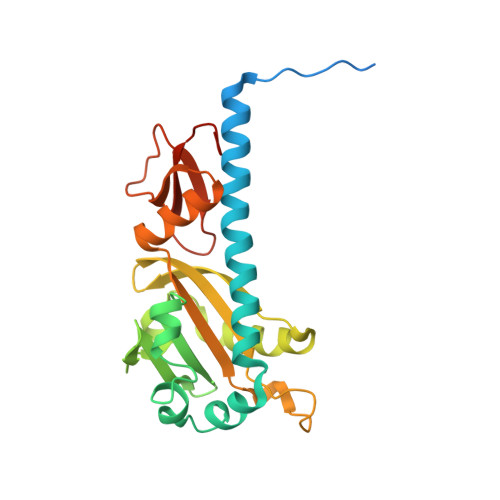A c-di-GMP signaling module controls responses to iron in Pseudomonas aeruginosa.
Zhan, X., Zhang, K., Wang, C., Fan, Q., Tang, X., Zhang, X., Wang, K., Fu, Y., Liang, H.(2024) Nat Commun 15: 1860-1860
- PubMed: 38424057
- DOI: https://doi.org/10.1038/s41467-024-46149-3
- Primary Citation of Related Structures:
8WCN, 8WCT - PubMed Abstract:
Cyclic dimeric guanosine monophosphate (c-di-GMP) serves as a bacterial second messenger that modulates various processes including biofilm formation, motility, and host-microbe symbiosis. Numerous studies have conducted comprehensive analysis of c-di-GMP. However, the mechanisms by which certain environmental signals such as iron control intracellular c-di-GMP levels are unclear. Here, we show that iron regulates c-di-GMP levels in Pseudomonas aeruginosa by modulating the interaction between an iron-sensing protein, IsmP, and a diguanylate cyclase, ImcA. Binding of iron to the CHASE4 domain of IsmP inhibits the IsmP-ImcA interaction, which leads to increased c-di-GMP synthesis by ImcA, thus promoting biofilm formation and reducing bacterial motility. Structural characterization of the apo-CHASE4 domain and its binding to iron allows us to pinpoint residues defining its specificity. In addition, the cryo-electron microscopy structure of ImcA in complex with a c-di-GMP analog (GMPCPP) suggests a unique conformation in which the compound binds to the catalytic pockets and to the membrane-proximal side located at the cytoplasm. Thus, our results indicate that a CHASE4 domain directly senses iron and modulates the crosstalk between c-di-GMP metabolic enzymes.
Organizational Affiliation:
College of Life Sciences, Northwest University, Xi'an, ShaanXi, China.















